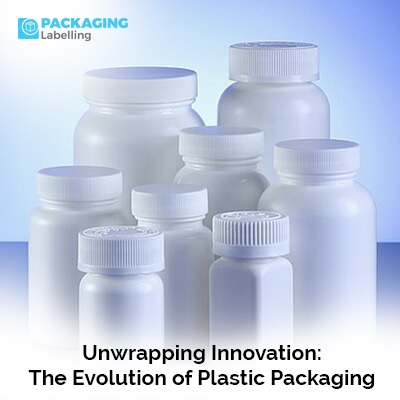Unwrapping Innovation: The Evolution of Plastic Packaging

Plastic packaging has come a long way since its inception, revolutionizing the way products are preserved, transported, and displayed. In this article, we delve into the fascinating evolution of plastic packaging and uncover the innovative solutions that have shaped this industry.
The history of plastics packaging
Plastic packaging has a rich history that dates back to the early 20th century. The first plastic containers were made from materials such as celluloid and bakelite, which provided a lightweight and durable alternative to traditional packaging options. However, it wasn't until the 1950s that the plastics packaging industry took off, with the introduction of polyethylene and polypropylene.
These new materials offered improved flexibility and strength, allowing for the creation of a wide range of packaging options. From bottles and cans to bags and pouches, plastic packaging quickly became the go-to choice for manufacturers across various sectors. Its ability to protect products from moisture, light, and other external factors made it an indispensable tool in the world of packaging.
The evolution of plastic packaging technologies
Advancements in technology have played a crucial role in the evolution of plastic packaging. With the introduction of blow molding and injection molding processes, manufacturers were able to create packaging that was not only functional but also aesthetically pleasing. This opened up new possibilities for branding and marketing, as packaging became an important tool for capturing consumers' attention and driving sales.
Over the years, new technologies have continued to push the boundaries of plastic packaging. From the development of barrier films that provide enhanced protection to the use of smart packaging solutions that offer real-time information, the industry has seen tremendous innovation. These advancements have not only improved the functionality of plastic packaging but have also helped reduce costs and increase efficiency.
The impact of plastics packaging on the environment
While plastic packaging has undoubtedly revolutionized the way products are packaged and displayed, it has also raised concerns about its impact on the environment. The durability of plastic means that it can take hundreds of years to decompose, leading to an accumulation of plastic waste in landfills and oceans. This has prompted a growing awareness of the need for more sustainable packaging solutions.
Innovations in sustainable plastic packaging
In response to the environmental concerns surrounding plastic packaging, the industry has been working towards developing more sustainable options. One such innovation is the introduction of biodegradable and compostable plastics. These materials are designed to break down more quickly and harmlessly in the environment, reducing the long-term impacts of plastic waste.
Another area of innovation is the use of recycled plastics in packaging. By reusing plastics that would otherwise end up in landfills, manufacturers can reduce their reliance on virgin materials and minimize the environmental footprint of their packaging. This trend towards recycling and repurposing plastics is driving the circular economy, where materials are kept in use for as long as possible.
| Also Read: Beyond The Bin: Rethinking Plastic Packaging for a Sustainable Future |
Advantages and disadvantages of plastic packaging
Plastic packaging offers numerous advantages that have contributed to its widespread adoption. Its lightweight nature makes it cost-effective to transport, reducing fuel consumption and carbon emissions. It is also highly versatile, allowing for the creation of packaging that can be customized to meet the specific needs of different products. Additionally, plastic packaging provides excellent protection against moisture, light, and other external factors, ensuring the integrity and freshness of the products inside.
However, plastic packaging also has its drawbacks. As mentioned earlier, its durability means that plastic waste can persist in the environment for hundreds of years. This has led to concerns about the pollution of ecosystems and the impact on wildlife. Furthermore, the production of plastics requires the extraction of fossil fuels, contributing to greenhouse gas emissions and climate change.
The future of plastic packaging
Despite the challenges, the future of plastic packaging looks promising. The industry is embracing innovation and investing in research and development to find sustainable solutions. This includes exploring alternative materials, such as plant-based plastics and biopolymers, as well as developing new recycling technologies. Additionally, there is a growing emphasis on designing packaging that is not only functional but also easily recyclable or compostable.
Case studies of successful plastic packaging innovations
Several companies have already made significant strides in developing innovative plastic packaging solutions. One such example is the introduction of edible packaging, where the packaging itself can be consumed along with the product. This not only reduces waste but also provides a unique and interactive experience for consumers.
Another notable innovation is the use of active packaging technology. This involves incorporating additives or sensors into the packaging material to extend the shelf life of the product or provide real-time information about its freshness. This not only helps reduce food waste but also enhances the overall consumer experience.
The role of consumer behavior in shaping plastics packaging
Consumer behavior plays a crucial role in shaping the future of plastic packaging. As consumers become more aware of the environmental impact of packaging, their preferences are shifting towards more sustainable options. This has prompted companies to rethink their packaging strategies and invest in eco-friendly alternatives. Additionally, consumer demand for convenience and ease of use has led to the development of packaging solutions that are lightweight, portable, and easy to open.
Conclusion: Embracing innovation for a sustainable future in plastic packaging
In conclusion, plastic packaging has undergone a remarkable evolution, driven by technological advancements and the changing needs of consumers and businesses. While it has provided numerous benefits, it has also raised concerns about its impact on the environment. However, the industry is rising to the challenge, investing in sustainable solutions and embracing innovation. By developing more eco-friendly packaging options and promoting recycling, we can pave the way for a more sustainable future in plastic packaging. It is up to all stakeholders, including manufacturers, consumers, and governments, to work together and make a positive impact on the environment while still enjoying the benefits of plastic packaging.









